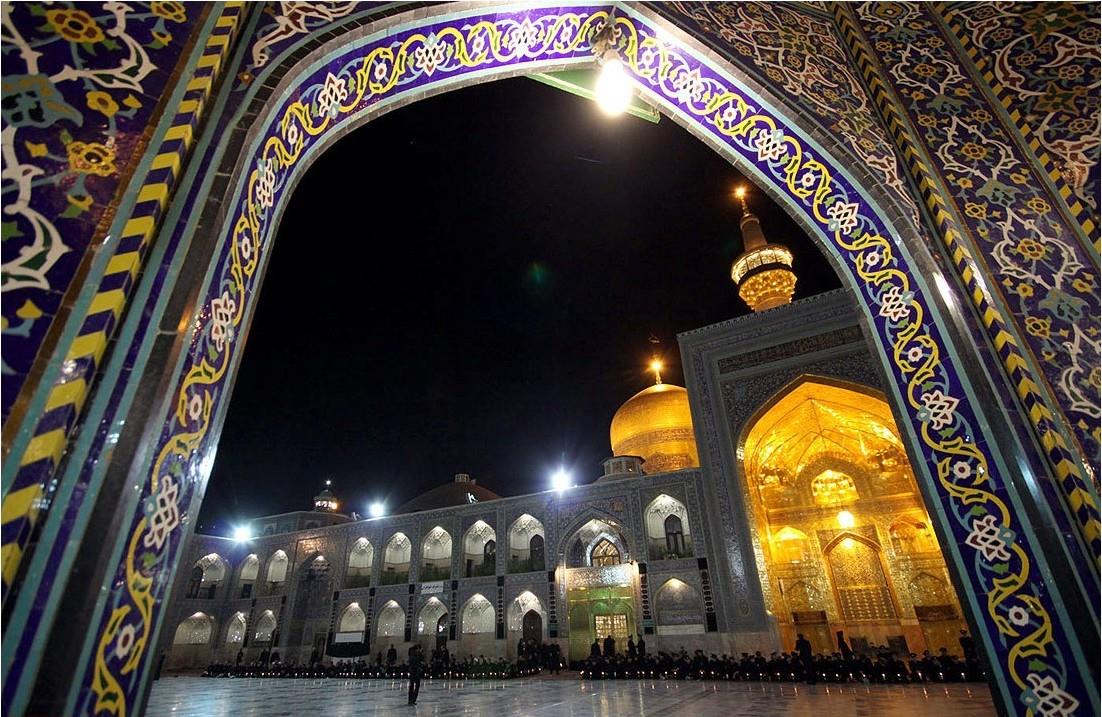
Rites & Rituals
1) Preparation starts in one’s own hometown by making one’s intention or nee’yat for making the pilgrimage.
2) Next the pilgrim should make him/herself spiritually clean by make major ablution or ghosl, then minor ablution or wozo, and reciting specific supplications and salutations or zee’ārat just before setting off.
3) When arriving in Mashhad, spets 1 & 2 are repeated and before going to the Holy Shrine, the pilgrim should be physically clean as well. Hence, s/he should have sweet breath, a clean body and clothes and use natural scents (for men).
4) It is highly recommended for the pilgrim to start to ponder and focus his/her attention on the amazing spiritual action s/he is about to embark on. Hence, when walking toward the Holy Shrine Complex, the pilgrim should walk slowly and purposefully. His/her head should be down in reverence and his/her eyes should not wonder around. It's tempting to become swept away by the new and magnificent scene, but one should not forget that the ultimate purpose of this visit is the pilgrimage.
5) While walking the pilgrim should continuously recite takbir [Allahu-Akbar (God is Great), Alhamduillah, and Subhanallah), لَا اِلٰہَ اِلَّا اللہُ(There is no god· but Allah), and salawat. Reciting these phrases calls the worshipper's attention to the fact that although they will be making pilgrimage and asking intercession of the Holy Imam, it is God the al-Mighty and Merciful that grants our supplications.
6) After passing the security point: Just as you ask permission to enter someone's home, as a sincere pilgrim, you should be courteous and ask first God, the Holy Prophet Mohammad (PBUH&F), then the Imam, and then the angles guarding the Shrine for permission to enter. There is a copper plaque posted on columns with the specific supplication and salutations or Zee’arat in Arabic and Persian pilgrims should recite before entering the Haram. (Follow the link for the English translation).
Seeking permission to enter:
O Allah, I stand still at one of the doors of the houses of Your Prophet (Your blessings be on him and on his children), because people are not allowed to enter without his permission. So You said: “O you who believe! Enter not the dwellings of the Prophet unless permission is granted to you.” O Allah ! I hold (as an article of faith) this honored place of pilgrimage as sacred, in his invisibility just as I was certain and sure of his sanctity in his presence. I know that Your Apostle and Your Representatives (peace be on them) are alive by Your permission and are being sustained, seeing my place of halting, hearing my words and answering my “Salaam”. Although You have shut off their speech from my hearing, you have unbolted the door of my understanding because of my delightful recitation of their merits. First I ask for Your permission, O my Lord, and then seek Your Apostle’s leave and take permission from Your representative, obedience unto whom has been made obligatory on me, Ali Ibn Moosa al-Reza (PBUH). And also from the angels, appointed as guardians of this blessed precinct. May I enter O Apostle of Allah? May I enter O Hujjatullah (proof of Allah)? May I enter O favorite angels of Allah, quartered in this place of pilgrimage? Give permission to enter, O my Master, a most cordial welcome that is extended to all of your closest friends; maybe I do not deserve it, but you are known to do it . (Taken from duas.org)
Important areas of the Haram that require the recitation of pilgrimage supplications or zee’a’rat are before entering the Holy Complex, the eastern area of the holy burial chamber, which is at the blessed feet of the holy grave called Payeen-e-Pa-ye Mubarak-e-Hazrat, and the western area, which is at the upper side of the holy grave, called Bala-ye-Sar-e-Mobarak-e-Hazrat.
According to narrations, if you feel a change in your heart, perhaps a lightness, ease, or tranquility (as some describe it) and your eyes become teary then it’s a sign that your permission to enter has been accepted.
Entering Sacred Grounds
In Islam, a mosque or masjid is considered a house of God with a spiritual atmosphere that allows worshippers to converse with God through specific rites and rituals as described in Islamic teachings. Also, burial places of the infallibles like the Prophets of God and the 14 ma'asoom are considered scared grounds as well as the Kabab (in Mecca).
In order to preserve the sacredness of these places, Islam has laid down specific rules. Ritual purity or taharat is the main requirement for anyone to enter a mosque.
Simply put, ritual purity can be divided into two main branches: 1) one pertaining to the heart and the other 2) pertaining to physical actions. Pertaining to the heart includes affirmation of faith in Islam. A few physical aspects are eating halal food, abstaining from alcoholic beverages, making major bathing ablution or ghosl, making minor ablution or wozo, wearing clean clothes, having a pleasant scent, and observing the required religious dress codes.
Hence, certain areas of the Holy Shrine are off limits to Non-Muslims: the Holy Burial Chamber, and Gowharshad Mosque.
Non-Muslims Visiting the Haram
Not every piece of ground in the Haram is considered a mosque or sacred ground; therefore, the entire Haram is not totally off limits to non-Muslim visitors. Non-Muslim visitors should check with the Office of International Relations and Foreign Pilgrims Affairs located in Dar ol-Rahmah Arcade to know what areas of the Haram are open for them to visit. Tours of these areas can also be arranged.

